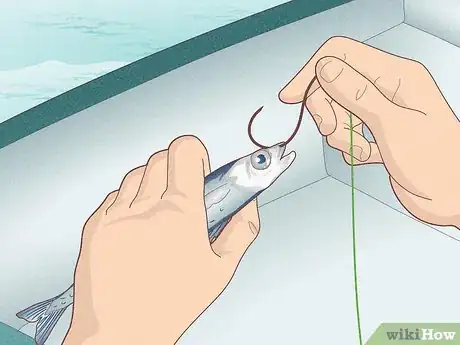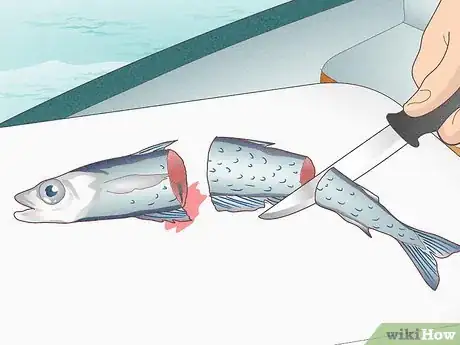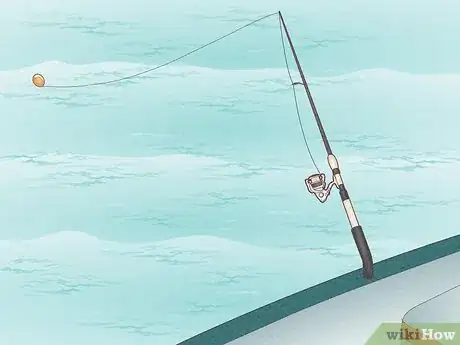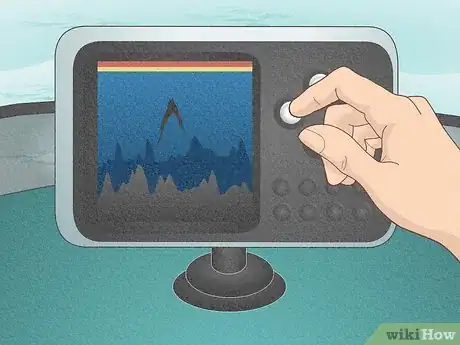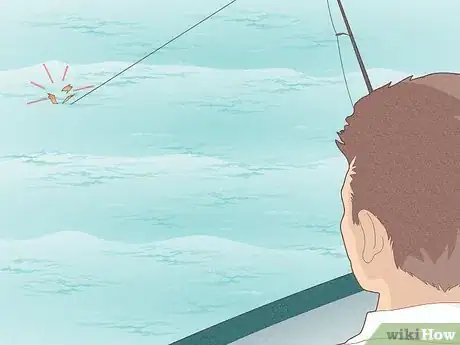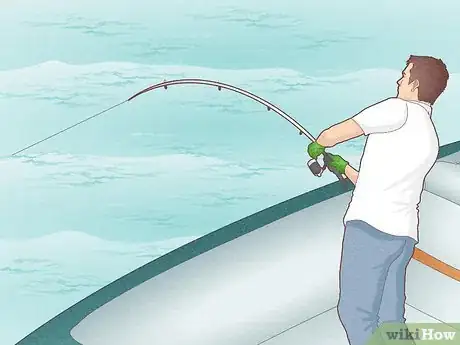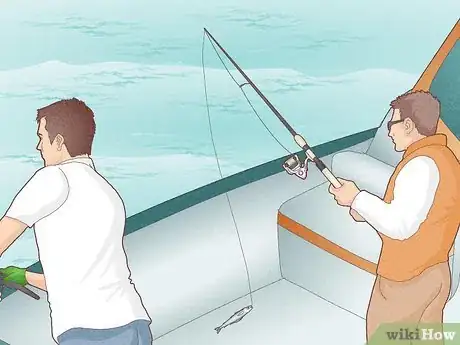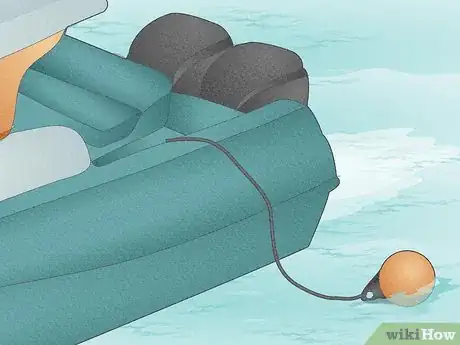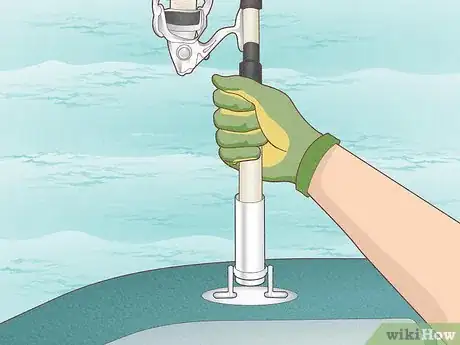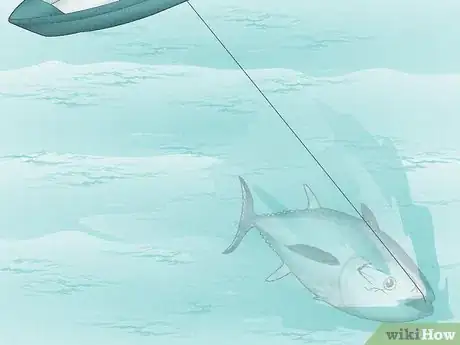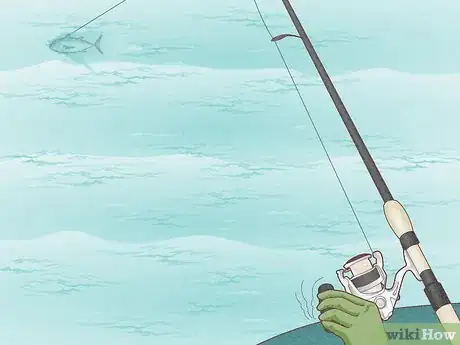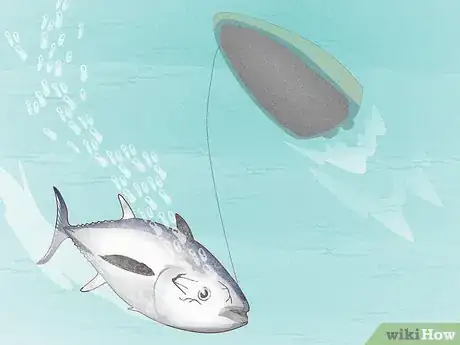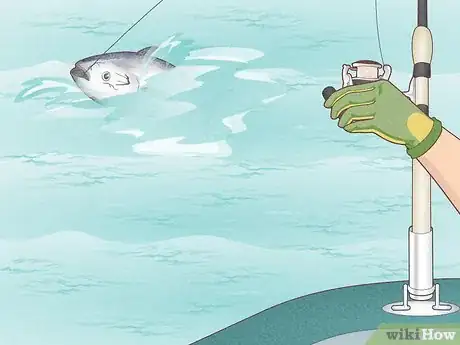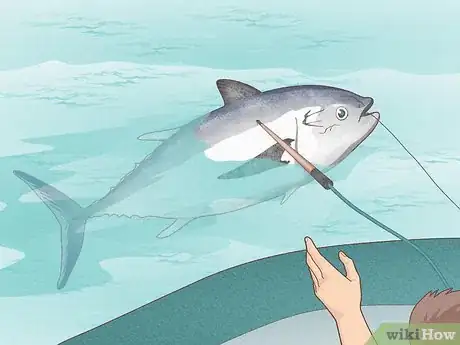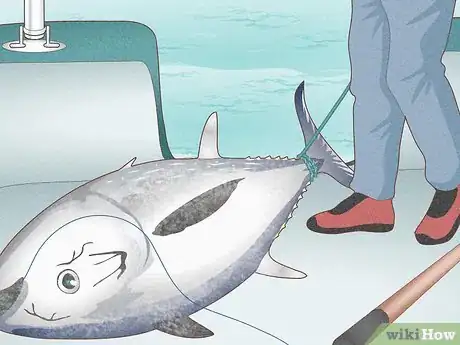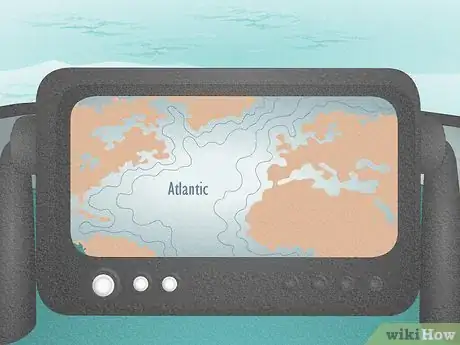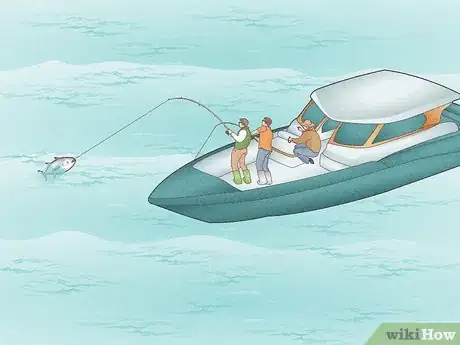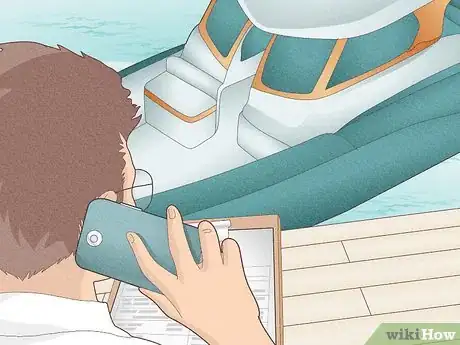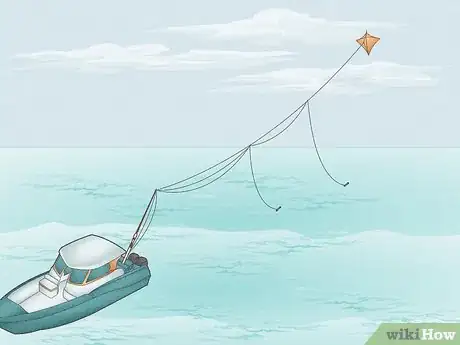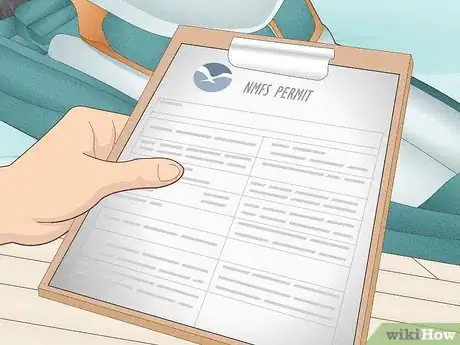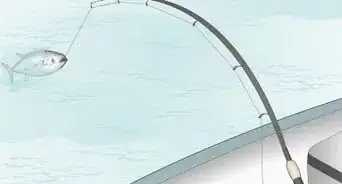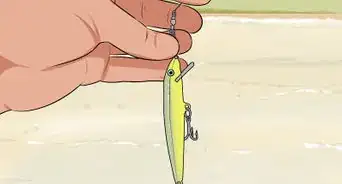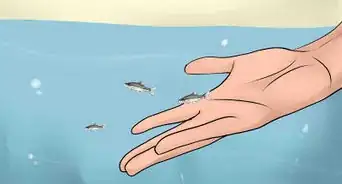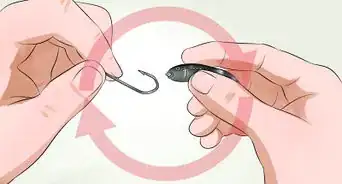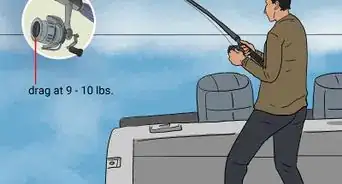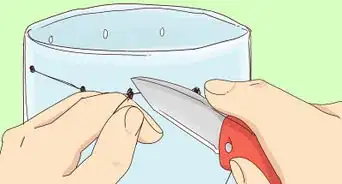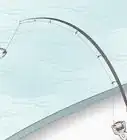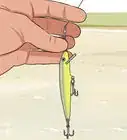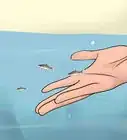wikiHow is a “wiki,” similar to Wikipedia, which means that many of our articles are co-written by multiple authors. To create this article, 29 people, some anonymous, worked to edit and improve it over time.
This article has been viewed 203,945 times.
Learn more...
Bluefin tuna range from 300 to 1000+ pounds, and catching them delivers a physical fight and a massive adrenaline rush. With the right permit, boat and equipment, as well as a good amount of physical strength, you can catch bluefin tuna for yourself.
Steps
Set Your Bait and Wait for Your Catch
-
1Hook live bait, like whiting or herring, through the nose. Place your bait at various depths to create an attractive setup, setting out the shallowest lines first and the deepest lines last so that the lines don't become tangled.
-
2Cut whiting or herring in 3 to 4 pieces to create a chum slick.
- Toss the pieces off of the transom until you have a visible chum click. Toss in new pieces every minute or so to keep the chum slick constant.
- Make sure that your hooked baits are within the chum slick.
Advertisement -
3Set the balloon and allow the bait to drift away from the boat.
-
4Watch your sounder. If you are finding fish at different depths than the depths at which you set your bait, then you may want to change your bait depth. A bluefin will be 20 to 30 feet (6 to 9 m) on your fish finder and will have a characteristic hump shaped like an upside-down "V."
Hooking the Bluefin
-
1Listen for a balloon pop. If you hear a pop, your rod is bent and line is stripping off of the reel at top speed, then you've probably hooked a bluefin.
-
2Jump on the rod and reels and used a gloved hand to make sure that the line stays taut. Keep the rod tip pointed at the fish.
-
3Have other people wind up the other lines and store the rods. The rods can be stored in the cabin or in the opposite gunwale from the hooked line.
-
4Release the anchor ball and start the engines. Clear the deck as needed.
-
5Move the hooked rod to the fighting swivel holder.
-
6Determine the direction of the bluefin. Steer the boat so that the line is 45 degrees aft and off of the gunwale.
-
7Keep the line tight during the initial runs. If the bluefin turns and starts to swim toward you, your line may go slack and fool you into believing that your catch got away. Reel as fast as you can to keep up with the fish and to restore the tightness of the line.
-
8Watch for the death circle. After a few runs, the tuna will start to circle under your boat. Apply constant pressure to wear down your fish by inching the drag up and switching to a lower gear on your reel to bring the fish up toward the boat. Make sure that you pull the fish away from your engine so that your line doesn't get caught in the props.
-
9Prepare for another run when the fish surfaces. When your bluefin sees your boat, it may make another break for it.
-
10Harpoon the fish when it is spent and near the boat. Aim to get the dart behind the fish's shoulder.
-
11Pull the fish in at a sidewards angle to give the gaffer a good shot. Gaff the fish in the head and pull it against the boat to tail rope it.[1]
-
12Hoist the fish onto the boat and bleed it while it's still alive. When the fish comes over the side of the boat, put your reel in free spool and keep your finger on the spool to keep the rod from loading up with the fish hits the deck.
-
13Take out the hook. If your fish swallowed the hook, then cut your line to release the fish.[2]
Other Recommendations
-
1Journey to the Atlantic and to adjacent seas to find bluefin tuna. Bluefins live in the Atlantic Ocean and spawn either in the Gulf of Mexico or in the Mediterranean Sea. Every spring, they migrate to the places where they were born.
- As they travel back and forth between spawning grounds, they can be caught off of the North American coast, particularly in the Virginia/North Carolina area and off of Massachusetts, New Hampshire and southern Maine.
- They also congregate in the Eastern Atlantic. Bluefins used to populate the Black Sea, although their population has dropped significantly here.[3]
-
2Take a few chartered fishing trips to catch bluefin before you strike out on your own. You'll learn about the procedure and about the equipment that you'll need, and you'll learn whether or not the sport is for you. Look online to find charter cruises in your area, particularly around Cape Cod and Cape Hatteras.
- Ask the captain whether you get to keep your catch (or if there is a weight limit) or if the fishing is catch and release.
- Your catch, if you get to keep it, may not be something you can legally sell. Have a plan for what you're going to do with all of this fish--sushi, anyone?[4]
-
3Know the regulations. Fishing regulations can be very confusing. Call 1-888-USA-TUNA for permits and to explore questions that you may have. Also, know your catch quota. Check with the NFMS for annual daily catch limits.
-
4Try kite fishing. Kite fishing allows an angler to keep a live bait swimming on the surface. The kite physically lifts the bait, and prevents the bait from swimming downward. The result is a live bait, virtually half out of the water, swimming and thrashing frantically on the surface-basically ringing the dinner bell for any tuna in the vicinity.
-
5Get the appropriate permits from the NMFS before you start fishing.
Community Q&A
-
QuestionWhen fishing for most tuna is it better to go deep?
 Community AnswerYes.
Community AnswerYes. -
QuestionDo the fishermen shoot the bluefin tuna in the head before bringing it on board? Couldn't they thrash around on board and break a leg?
 Phil HowarthCommunity AnswerNope, it is illegal to shoot tuna. Normally we "swim" the fish to let it release its lactic acid, we then rake its gills and it bleeds out whilst in the water, killing it. This is vital if you are going to sell the fish commercially.
Phil HowarthCommunity AnswerNope, it is illegal to shoot tuna. Normally we "swim" the fish to let it release its lactic acid, we then rake its gills and it bleeds out whilst in the water, killing it. This is vital if you are going to sell the fish commercially. -
QuestionHow long does it take on average to land a giant bluefin tuna?
 Phil HowarthCommunity AnswerAnywhere between 30 minutes to...well, I lost one at 8 hours and 3 minutes last season!
Phil HowarthCommunity AnswerAnywhere between 30 minutes to...well, I lost one at 8 hours and 3 minutes last season!
Warnings
- Avoid fish oil or ground-up chum in your chum slick. You will only attract sharks.⧼thumbs_response⧽
- Giant bluefin tuna have killed many fishers by dragging them overboard. Use extreme caution or hire a guide before you attempt to catch one of these fish.⧼thumbs_response⧽
Things You'll Need
- Federal permits
- A 30-foot (9 m) boat that can travel 50 miles (80 km) offshore
- Bait (scaled whiting or herring for chum or a fresh whiting or herring on a line)
- 8-foot (2.5 m) 130-lb. (59 kg) or unlimited class rod
- 130-class reel with double speed feature
- Braided dacron fishing line (you can lead with the braided line and use a topshot of 200-lb. (91 kg) test monofilament running line)
- 8 to 15 feet (2.5 to 4.5 m) of fluorocarbon leader at 180 to 200-lb. (82 to 100 kg) test strength
- 250-lb. (113 kg) swivel
- Hooks (7/0 to 11/0)
- Crimps with chafe tube (wrapped with black electrical tape to reduce visibility)
- 20 to 30-oz. (0.55 to 0.85 kg) lead bank sinker
- Balloon with sliding clips
- Gloves with rubber palms
- 90-degree swivel rod holders with backing plates
- Anchor with mooring ball and retrieval ring, 75" (2 m) mooring line
- Fish finder
- Navigation equipment including GPS
- VHF
- Live well
- Chunking station
- 2 harpoons
- 2 offshore gaffs
- Tail and tow rope
- Gin pole/block and tackle
- 128+-quart coolers, cooler for crushed ice
- Safety items - EPIRB, flares, life rafts, immersion suits
- Fuel for your boat
References
About This Article
To catch bluefin tuna, your best bet is to fish off the North American Atlantic coast or in the Eastern Atlantic. When you fish for bluefin tuna, use whiting or herring as live bait and to make a chum slick. As you're fishing, toss in new pieces of fish every minute so the chum slick is constant. Once you hook a bluefin tuna and tire it out, wait until it's close to the boat before harpooning it behind its shoulder. Then, hoist the fish onto your boat. To learn how to catch bluefin tuna by kite fishing, scroll down!
